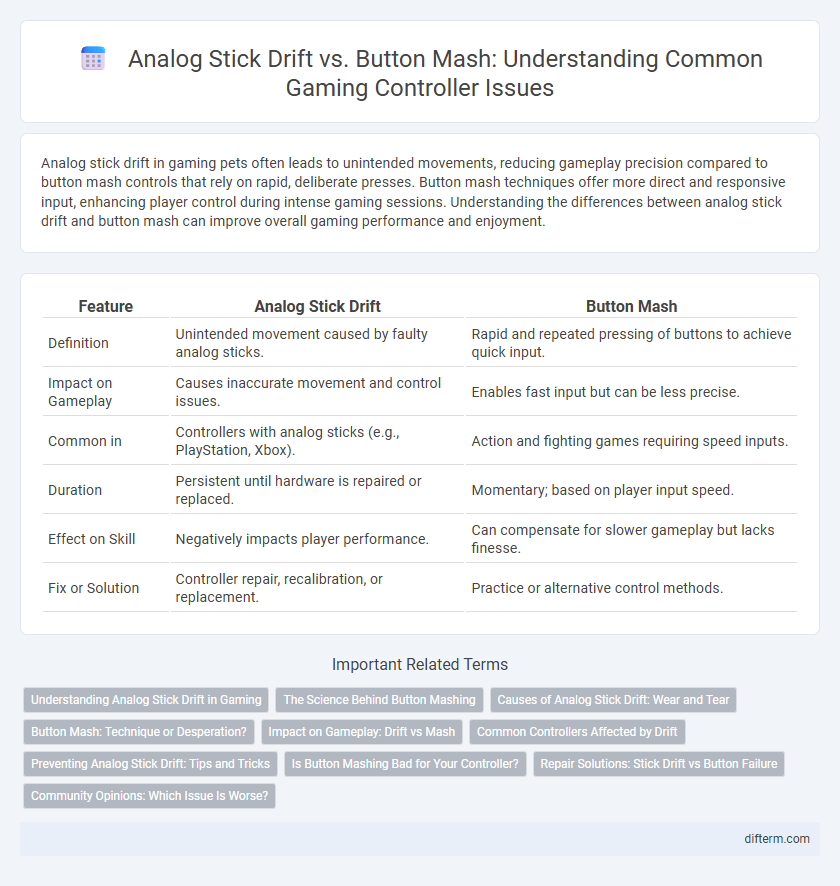Analog stick drift in gaming pets often leads to unintended movements, reducing gameplay precision compared to button mash controls that rely on rapid, deliberate presses. Button mash techniques offer more direct and responsive input, enhancing player control during intense gaming sessions. Understanding the differences between analog stick drift and button mash can improve overall gaming performance and enjoyment.
Table of Comparison
| Feature | Analog Stick Drift | Button Mash |
|---|---|---|
| Definition | Unintended movement caused by faulty analog sticks. | Rapid and repeated pressing of buttons to achieve quick input. |
| Impact on Gameplay | Causes inaccurate movement and control issues. | Enables fast input but can be less precise. |
| Common in | Controllers with analog sticks (e.g., PlayStation, Xbox). | Action and fighting games requiring speed inputs. |
| Duration | Persistent until hardware is repaired or replaced. | Momentary; based on player input speed. |
| Effect on Skill | Negatively impacts player performance. | Can compensate for slower gameplay but lacks finesse. |
| Fix or Solution | Controller repair, recalibration, or replacement. | Practice or alternative control methods. |
Understanding Analog Stick Drift in Gaming
Analog stick drift occurs when the joystick on a game controller registers movement without input, often caused by wear or dust buildup affecting the sensor's accuracy. This issue disrupts precise control in gameplay, especially in genres requiring fine directional input like first-person shooters or racing games. Unlike button mashing, which is rapid and deliberate input pressing, analog stick drift is an involuntary hardware malfunction impacting player performance and immersion.
The Science Behind Button Mashing
Button mashing relies on rapid, repeated inputs that exploit a controller's signal processing limits, often overwhelming the game's input recognition to achieve quick in-game actions. Unlike analog stick drift, which results from physical wear causing unintended inputs, button mashing leverages the brain's motor patterns and reaction times to generate high-frequency commands. Research in neuromuscular responses shows that players can achieve faster input rates through button mashing, though accuracy and timing often suffer compared to controlled analog movements.
Causes of Analog Stick Drift: Wear and Tear
Analog stick drift primarily arises from the physical wear and tear of the joystick's internal components, such as the potentiometers that detect movement. Continuous, repetitive use causes these sensors to degrade over time, leading to unintended directional inputs. Unlike button mashing, which demands rapid presses, analog stick drift results from mechanical decay that impacts precise control in games.
Button Mash: Technique or Desperation?
Button mashing in gaming often reflects a desperate attempt to regain control or overcome difficult sections but can occasionally be a viable technique in fast-paced or reaction-based scenarios. Unlike analog stick drift, which is a hardware issue causing unintended in-game movements, button mashing relies solely on rapid, repetitive input from the player. While it lacks precision, effective button mashing can sometimes exploit game mechanics or overwhelm opponents in certain fighting and action games.
Impact on Gameplay: Drift vs Mash
Analog stick drift causes unintentional character movement, disrupting precise control and leading to frustration in competitive gaming environments. Button mashing, while less precise, allows for rapid input during chaotic combat scenarios but often sacrifices strategic play. Drift impairs accuracy and responsiveness, whereas button mashing impacts gameplay flow and strategic depth.
Common Controllers Affected by Drift
Common gaming controllers affected by analog stick drift include the Sony DualShock 4, Nintendo Switch Joy-Con, and Xbox Elite Series 2, where wear on potentiometers or sensors causes unintentional movements. Unlike button mashing, which relies on rapid, repetitive presses without hardware issues, analog stick drift results in persistent, inaccurate input even without user interaction. This phenomenon significantly impacts gameplay precision, particularly in genres requiring precise directional control such as shooters and racing games.
Preventing Analog Stick Drift: Tips and Tricks
Preventing analog stick drift begins with regular cleaning using compressed air to remove dust and debris beneath the joystick. Applying a small amount of isopropyl alcohol with a cotton swab helps maintain sensor responsiveness and prevents grime buildup. Avoid excessive pressure or aggressive movements during gameplay to extend the lifespan of the analog sticks and ensure consistent performance.
Is Button Mashing Bad for Your Controller?
Button mashing can accelerate wear and tear on your controller's buttons due to rapid, repeated impacts causing rubber membrane degradation and potential internal contact issues. While analog stick drift primarily results from sensor wear and dust accumulation, excessive button mashing stresses mechanical components, reducing overall controller lifespan. Using controlled presses and avoiding frantic mashing preserves button responsiveness and extends controller durability.
Repair Solutions: Stick Drift vs Button Failure
Analog stick drift often requires thorough cleaning or replacement of the potentiometer to restore precise control, while button mash issues typically involve fixing or replacing worn-out contact pads or switches. Repair kits for stick drift include tools such as isopropyl alcohol and replacement analog modules, whereas button failure solutions focus on soldering new microswitches or membrane sheets. Utilizing specialized repair kits can extend the lifespan of controllers by targeting the specific hardware failures causing analog drift or unresponsive buttons.
Community Opinions: Which Issue Is Worse?
Gamers often debate analog stick drift versus button mash, highlighting distinct frustrations in each issue. Analog stick drift, which causes unintended movement, disrupts gameplay precision in titles like first-person shooters and racing games, often requiring expensive controller repairs. Button mash, while less hardware-dependent, signals a lack of skill or strategy, sparking discussions about player behavior and esports legitimacy within the gaming community.
analog stick drift vs button mash Infographic

 difterm.com
difterm.com